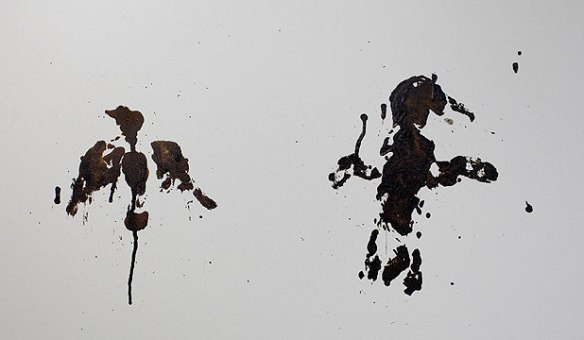 The Slick exhibition was set up as a project between Nelson artists and school children aimed at showing how dependent we are on oil based products in everyday life, and bringing awareness to the hazards of oil drilling in New Zealand waters.
The Slick exhibition was set up as a project between Nelson artists and school children aimed at showing how dependent we are on oil based products in everyday life, and bringing awareness to the hazards of oil drilling in New Zealand waters.
One of the artworks created by the pupils, that they call the ‘Oillution Curtain’ was made out of recycled ice-cream containers, and was painted black merging into blue and white representing at-risk oceans.
Pupil Zoe Fyfe, 11, said the work showed oil invading over the water and killing everything that was healthy (reference for this quote from Nelson Mail/Stuff)
See more information behind this exhibition here. And read more about the students learning and artistic experience here, along with seeing a picture of their artwork.
From the awareness of how dependent we are on this substance a lot know as ‘black gold’ we go to one of the destructive aspects of oil, showing the effects of oil spills in our oceans.
On 5th October 2011 the Rena disaster happened in New Zealand waters, just off the coast of Tauranga. The boat ran aground resulting in 350 tonnes of oil to spill from the wreckage. Thousands of birds were found coated in thick, black, sticky oil and more than 2000 birds died in this tragedy. The ecosystems and food sources of these birds were also contaminated.
Along with it being an environmental disaster for this country a lot of money has had to be spent on the Rena clean up. Maritime New Zealand recently calculated that $27.7 million has been spent so far.
The birds that survived spent time in a Wildlife Recovery Centre being nursed back to health. One creative way that people helped to make a difference for the little blue penguins caught in this oil spill was to knit little jumpers for them. These helped to protect them and prevented them from preening their feathers and ingesting the toxic oil. (Penguin image right)
Some of the most memorable images emerged from this disaster. I remember seeing huge posters plastered up around the centre of Wellington with the haunting black oil prints of the small birds bodies pressed onto a stark white background. These images have stayed with me months down the track. (Above image by Nigel Marple-Greenpeace.)
And so did this short Greenpeace video:
Read more about the oil bird prints here.
See more of the pictures from the exhibition. (click on the exhibition tab more pictures).
Further afield some of Daniel Beltra’s environmental photographs of a Deepwater Horizon oil spill off the coast of Florida 2010 are featured in the ‘Looking back at Earth’ exhibition at the Hood Museum of Art in the United States of America.
“Beltra’s simultaneously vibrant and unsettling documentation of the BP oil spill characterizes the 23-piece exhibit, which combines aesthetic beauty with underlying environmental significance.” Reference from the article ‘Hood Museum exhibits Daniel Beltra’s environmental photography’ read more here.
The images showing the oil spill from an arial view are quite beautiful in a way (the colours and patterns in the photos, not the oil spill itself). From a distance, at a birds eye view they also show us the sheer magnitude of events like this. They are sobering images.
Check out more of Daniel Beltra’s amazing photos and learn more about him on his website.


